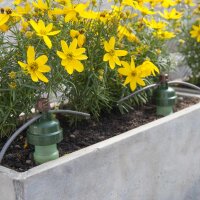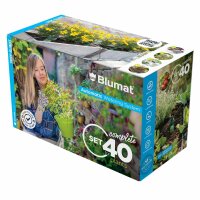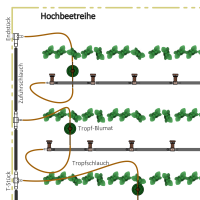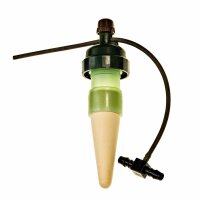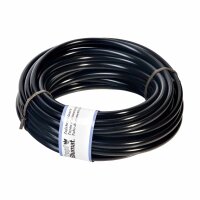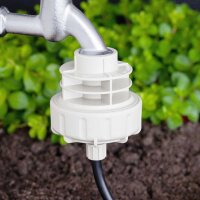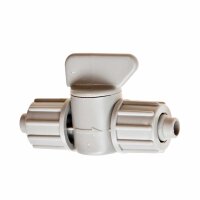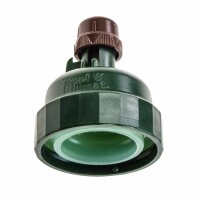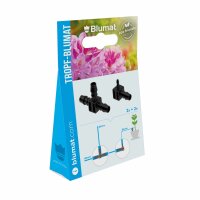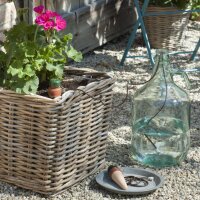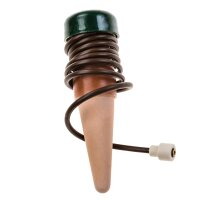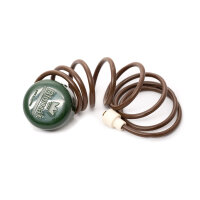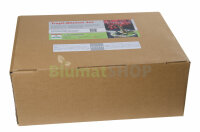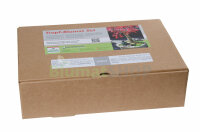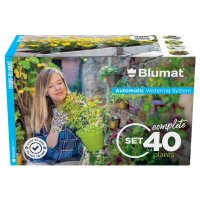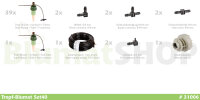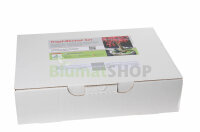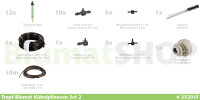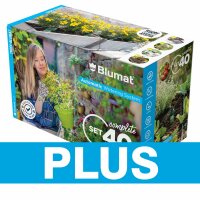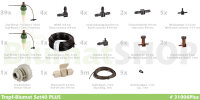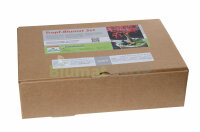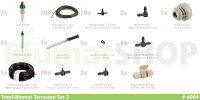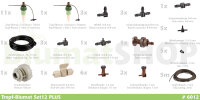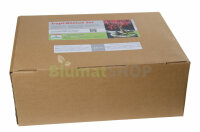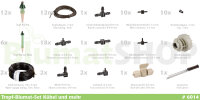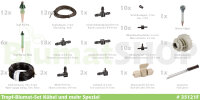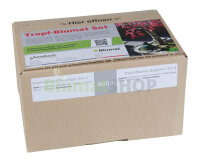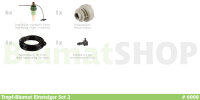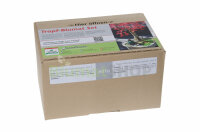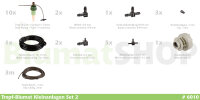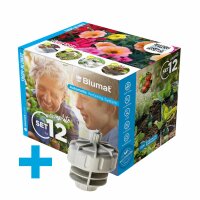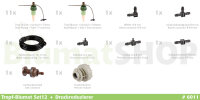Special set designed for watering in shallow dishes such as used for Bonsai plants, for depths of over 2.5 cm, also suitable for small pots of 10 or more cm.
Water supplied from a faucet (connection to house water or other water supply).Information on product safety
Manufacturer information:
Name: bambach GbR
Street name: Peter-Spring-Str. 18
Postal code, City: 65366 , Geisenheim
Country: Deutschland
State: Hessen
Homepage: https://www.bambachgbr.de
Street name: Peter-Spring-Str. 18
Postal code, City: 65366 , Geisenheim
Country: Deutschland
State: Hessen
Homepage: https://www.bambachgbr.de
Product safety information
Manufacturer information:
bambach GbR
Peter-Spring-Str. 18
Hessen
Geisenheim, Deutschland, 65366
https://www.bambachgbr.de
Peter-Spring-Str. 18
Hessen
Geisenheim, Deutschland, 65366
https://www.bambachgbr.de
- Product type: Irrigation set
- Water connection: Faucet
- 10 Tropf-Blumat Bonsai (TB-Bonsai), without drip tubing and T-connector
- 10 m water supply tubing, black, 8mm
- 15 m drip tubing, 3mm
- 10 T-connectors, 8-3-8 mm
- 10 mini-branch-connectors, 3-3-3 mm
- 10 mini-connectors
- 5 end caps, 3 mm
- 1 end piece, 8-3 mm
- 1 Bonsai corer, 15 mm
- 1 pressure reducer
Set is suitable for (alternative examples)
- 10 shallow Bonsai dishes, 15-20 cm
- 5 shallow Bonsai dishes, up to 50 cm
- 10 small pots
Setting-up Tropf-Blumats – number required
The TB-Bonsai has the same features as the normal size Tropf-Blumat; however, the form and the set-up are different. Watering is regulated primarily by the ‘drip spacing’; for example, it can be adjusted in a range from 2-5 cm (see suggested set-up).1 TB-Bonsai is enough for a 15-20 cm size dish. Large dishes (up to 50 cm) should have at least 2 TB-Bonsai depending upon the arrangement of the Bonsai plants, and also as a back-up for a malfunctioning sensor.
Larger dishes can often be adequately watered by extending the tubing further from the sensor – for instance, 10-15 cm.
Unique Features of this Set
The unique feature here is the shortened clay form of the TB-Bonsai which is designed specially for use in shallow dishes. The normal Tropf-Blumat form is too long for this purpose.The drip tubing is individually cut to the desired length and is attached to the watering head at the desired spacing (see Drip Spacing).
The mini-branch connectors make it possible to create a branch in the drip tubing, so that two dishes or two TB-Bonsai in one large dish can be supplied using one drip tubing connection to the water supply tubing. With the mini-connectors and the end caps for closing a 3 mm nozzle, it is possible to create combinations which allow for the removal a dish for maintenance purposes and care of the plants. More than enough fittings are included to allow for branching the system and frequent changes.
The Bonsai corer allows for the creation of an exactly fitting hole for the short clay Tropf-Blumat cylinder.
Connection to tap water
The required pressure reducer fits a standard water faucet with ¾ inch outer threading. The water faucet must be kept constantly open for operation of the system. If the water tap is to be used for a garden hose in addition, then it is practical to use an optional 2-Way-Branch Connector, this allows for the watering functions (hose or Tropf-Blumat) to each be used separately.The pressure reducer sets the pressure at 1 (0.8) bar, the pressure from the water source should not exceed 6 bar. It is also possible to connect to a house tap with less upstream pressure.
It is important, that the pressure reducer be stored over winter protected from frost, or for the purpose of winter operation, that the water connection is located in a frost-free cellar.
Tubing Installation
The 8 mm-water supply tubing should be placed alongside the Bonsai dishes or possibly a bit further away for the purpose of hiding the tubing under an edge. For each dish or between two dishes, the tubing is cut and a t-connector is inserted into the two ends of tubing (for the last Tropf-Blumat at the end of the tubing, use an end piece instead of a t-connector). The drip tubing is connected at these locations. The length of the individual drip tubing should be at the most 1.5 m in order to keep the loss of pressure at a minimum, an occasional control with flushing is recommended.The installation can be laid out as desired, the tubing can be branched, and there can be some variation in elevation within the layout, for example, from the point of the faucet upwards max. 4-(6) m and downwards ca. 2-(3) m.
The water supply tubing can be mounted using any wire fasteners or nail clamps, depending upon the specifics of the location.
System
"Tropf-Blumat" (Tropf = Drip) works using pressure as its basis, it requires a minimum pressure for the correct functioning of the watering head and to avoid cloggage.The Tropf-Blumat is the heart piece of the entire system and acts as a moisture sensor and dripper at the same time. Every dripper location is therefore sensor controlled according to the tensiometer principle. Also included in the system are fittings to connect the tubing.
Procedure
Fill the Tropf-Blumat with water (part of the sensor function only!) – see Directions for Use – and insert into moist soil. As the soil becomes drier, water is sucked out of the feeler which is a porous clay cone. This creates a sub pressure (partial vacuum). As the pressure develops, a membrane in the watering head is released (before then it is squeezed together), opening the thin dripper tubing; the tubing begins slowly to drip. The water seeps through the soil once again to the clay cone, causing a lessening of the sub pressure, the valve closes; the dripping slowly stops.Adjusting
The Tropf-Blumat is adjusted using the brown knob; it should be set so that when the soil is optimally wet, the dripper has just stopped dripping. When first using, the sensor requires a certain settling period. Therefore, adjusting should be carried out only after a day of use. The general recommended adjustments are described in the Directions for Use or in our Recommended Settings. It is important that the adjustment is correct from the beginning!Maintenance
The water being used must be clean (there is no filter in the system), it can contain completely water soluable fertilizer. It is recommended to treat water that is extremely hard (over ca. 30°dH) by softening or to use rainwater, if possible. Light lime deposits in the tubing can be removed by rubbing.The water inside the sensor should be occasionally checked. However, in general, the water will not need to be topped off during the watering period. Under certain conditions, winter operation is also possible.

